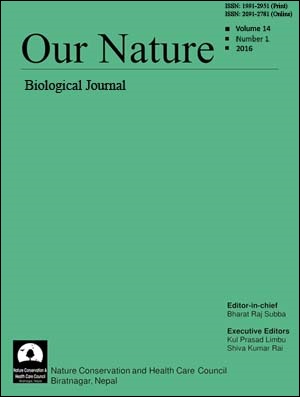Distribution pattern and species richness of Liliaceae in the Nepal Himalaya
DOI:
https://doi.org/10.3126/on.v14i1.16437Keywords:
Conservation, DIVA GIS, Lily, ModellingAbstract
The most important aspect of plant conservation is to predict the potential distribution and its richness in response to climate change. Contributing to the management program, this study aimed to predict the distribution and richness pattern of Liliaceae in Nepal. The BIOCLIM in DIVA GIS 7.5 model based on distribution records of 19 species belonging to three subfamilies of Liliaceae (Lilioideae, Streptopoideae and Calochortoideae) and 19 climatic variables (derived from Worldclim), revealed that Lilioideae and Streptopoideae are potentially distributed in most of the hilly and mountainous regions of Nepal; whereas Calochortoideae mostly in Eastern and very scanty in Central Nepal. Lilioideae is projected to have high species richness in Central and Western Nepal as compared to other subfamilies.

This work is licensed under a Creative Commons Attribution-NonCommercial 4.0 International License.
Downloads
Downloads
Published
How to Cite
Issue
Section
License
This license enables reusers to distribute, remix, adapt, and build upon the material in any medium or format for noncommercial purposes only, and only so long as attribution is given to the creator.




